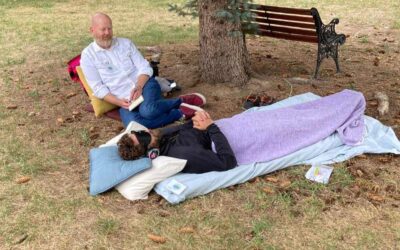If you intend to work with psychedelic medicines, if you intend to work with patients in the psychedelic framework and if you intend to have a practice in this arena, then you really should understand psychedelic medicine culture. The clientele drawn to this work and the work itself builds upon a foundation that can be called psychedelic. This word may mean different things to different people, but for those who work with psychedelic medicine the word implies a few key concepts that are worthy of elaboration. This unique perspective plays a central role in how this path of healing is considered. The culture of psychedelic medicine is a variation of a broader psychedelic culture, but there is massive overlap between the two. This essay explores the central features commonly found in the work with psychedelic medicine.Psychedelic medicine culture describes a range of things. It describes a mindset, a philosophy, a collection of values, a worldview, if you will. This worldview is cohesive and rather consistent. Much of this work has deep roots in shamanism and a range of indigenous practices that have endured for millennia, but our current era has merged this with many modern elements. This essay will not explore the origins, but will explore the most common facets that constitute our modern psychedelic medicine culture. The exact collection of beliefs varies person to person, but the core premises are rather consistent:
- We all possess an inner healer. Each individual carries an innate power to heal herself or himself. This inner healer heals body, mind, and spirit. The goal of treatment is to remove barriers and unleash our innate ability to heal ourselves. Early research supports the concept that this power to heal appears to be linked to an encounter with a mystical experience that may unleash the power of spirit.
- These medicines carry the capacity to catalyze an inner healing process. That unique power imbues these medicines with a sacred quality. This ability to trigger transformation and enhance our personal journey of discovery demands respect and appreciation. Although these medications work through many different biochemical pathways, they each can facilitate an inner process that supports a deep healing if we turn the experience inward.
- Music is central. While the definition of music may be broad, the value of music goes deep in psychedelic culture. Since time immemorial crafted sound has been a part of human ceremonies and spiritual practice. Music simultaneously carries us away and grounds us. Music can foster trance and cognitive engagement while lessening the neurological distraction of our created self (i.e. our self-referential thinking also known as the Default Mode Network). For these reasons and many more, music garners great respect and appreciation. While melody and lyrics play some role, it is the cognitive and emotional atmosphere generated by the music that drives the attraction in psychedelic culture. It supports and powers a journey rather than being a destination in and of itself. It may indeed be valued for its ability to imbue mystical qualities. Music is a carrier that supports the inner journey. Psychedelic art likewise becomes a common extension of the mystical frame. Music can support the mystical experience at the core of psychedelic medicine.
Together the sacred medicine, the inner healer, and mystical music constitute the core elements of psychedelic medicine culture. The medicine becomes the vehicle for exploration and also the catalyst the healing process. Imagine the inner healer as a sailor in a sailboat. The sailboat is the medicine, a tool for exploration. In this metaphor mystical music plays the role of the wind offering propulsion (without a specific destination). The ocean and all of the unknown lands that lie beyond represent the individual’s psyche including all of its conscious and unconscious elements. Some of this is a terra incognita and some of the paths are well worn. All together this inner world becomes the terrain for the journey itself.
To fully expand this metaphor, our current palette of sacred medicine could be seen as a fleet of sailboats, each with its own unique characteristics and benefits in the sea of consciousness. One sailboat is nimble and quick for short hauls (ketamine), one sailboat is sturdy and crafted for longer journeys and deep exploration (LSD), while another is better for cutting through the strong headwinds of trauma and relational conflict. (MDMA).
Psychedelic medicine culture reflects this wonderous interplay of inner healer, sacred medicine, and mystical music in the realms of the psyche. Psychedelic medicine culture posits that given the universality and sacredness of this inner exploration, access should be open ended and not limited by specific psychiatric diagnosis, but rather available to anyone with the intent to explore and heal. Given the unique qualities of this exploratory path, a deeply held credence in psychedelic medicine involves the need to personally experience this inner exploration before one can take on the role of guide. Therapists must have experiential exposure to the effects of these medicines before they are ready to conduct effective therapy. This may fly in contradiction to our current fading paradigm based on a purely pharmacological belief system. By contrast in this model the inner experience must lead and the pharmacology is only relevant as a vehicle to support this process. As you can see these three core elements carry significant implications for both training and the nature of psychedelic medicine practice.
Beyond these three core elements there are a number of less specific or central themes. The non-core elements actually flow from some common characteristics of the psychedelic experience itself. Psychedelics offer each person a new perspective and understanding of their existence. You might say that we live our lives with a street level view. Psychedelic medicines give us loft (height) so that we can have added perspective. It can be a view from a hot air balloon, airplane, satellite or asteroid. The perspective and distance offer a view of how connected, interdependent and precious each life is. This loft can carry huge insight, painful realizations, deep forgiveness or the detailed recall of trauma. This often-dramatic shift in perspective can help us re-orient and move out of a stuck place that limits our peace and joy.
The psychedelic experience has been compared to some facets of the boundary-free state found in mystical union or non-dual awareness. Studies of the mystical state highlight this sense of unity as the core experiential element. When it occurs, this experience on the psychedelic journey brings a profound sense of being interconnected and a part of the cosmic web of life. This experience creates a sense of deep ecology (human life is not the center of the universe) that cannot be unseen once it is perceived. The elements of psychedelic medicine culture that flow from this felt sense of unity include:
- A penetrating ecological awareness about how we exist in an interdependent web of life. We do not perceive a boundary between our existence and all else that lives. We sense a deep concern about the harm done to other organisms and ecosystems by human activity. Nature and wilderness become deeply sacred as one reflection of all that we truly are.
- A deeply felt sense of connection to our community and a love for the larger family of man.
- A desire to be of service and step past our innate proclivity for selfishness.
- An allergy to racism, sexism, elitism, ageism, etc. and all other manufactured boundaries that separate us from our fellow sentient beings.
- A number of the above elements combine to create a deep skepticism with the capitalistic mindset of extraction, exploitation and accumulation. Often, this becomes an even more pointed concern in the potential commodification of sacred medicines, ancient traditions or healing encounters. This also can express itself in passionate levels of political activism around these issues.
Psychedelic medicines often facilitate an encounter with something greater than ourselves that is ineffable. There are no words to convey the power of this encompassing insight or awakening. This frequently carries a sense that we have connected with some deeper truth about the nature of self, consciousness and our shared human experience. This can be called a noetic experience, but at its core this is a spiritual opening and a call to deeply consider our basic assumptions about our life and our impending death. This spiritual calling is not universal, but still quite common in a psychedelic session. It can be answered or ignored. The inward call can show up in many ways and these related elements seem to radiate from this intrinsic capacity of psychedelic medicine:
- A recurrent desire to explore the inner realms more fully. Someone may identify as a psychonaut (an inner voyager) or merely feel pulled to reflect deeply on experience, sensation and the passage of time. This inner pull can sometimes become imbalanced and a type of dependence or even avoidance behavior.
- A strong spiritual curiosity may arise with an interest in and respect for the many paths possible for personal development. Often this comes with a primary attraction to the mystical flavored personal experience and a deep skepticism about the preformed dogma found in organized religion.
- One common reflection of a deep spiritual connection is joy. Psychedelics can enhance our sense of play, the ability to laugh at ourselves and the pull to celebrate. Dance and the regular celebration of our physical being can be perceived as but one radiation of the divine impulse.
- This inner experience enhances our interest in consciousness itself as a phenomenon. This also carries a draw towards understanding the foundation and physics of our existence. We feel pulled to explore deeper fundamental questions. The curious gaps in our understanding of quantum mechanics draw attention. We may be perplexed by how biological systems can collapse the wave function at the foundation of quantum mechanics. Do we live in a biocentric universe? What is dark matter and dark energy? What existed before the Big Bang? These questions and others become prominent as we try to explain why we exist and how we got here.
Finally, experiences with psychedelics often help each individual to more fully appreciate the tremendous sanctity of life and the gift that we have each been given. This precious life that we experience links us to all organisms in the web of life so well described by Chief Seattle over 150 years ago. We ask deeper questions about this glorious mystery such as what is the nature of life?
Life describes the whole of our being, all of our organs and cells as well as the recurrent pull to higher levels of order. We grow from a single cell to tremendous complexity. Health, not illness is our default. Our body can heal itself. We recover from physical injury. But this healing also occurs on the mental and emotional level. This pull to order can be called the inner healer that guides us with inner wisdom. We strive to make meaning and organize our experiences into a coherent whole. The inner healer is the Self with a large S described by Jung. The Self embraces fully our strengths and our limitations. The Self understands persona and shadow. The Self recalls all of our trauma in great detail and comprehends all of the truth behind our deceptions. Most of all, the Self or inner healer can offer the guidance to deeply heal and perhaps to answer a deeper calling about purpose. The same self- organizing force that heals a cut on our skin also carries the mental, emotional and spiritual wisdom to heal. We may get lost through disconnection from our inner healer, but we are never without the Self. Psychedelic medicines support our reconnection with Self. The inner healer is our navigator that never gets lost.
Conventional psychiatry has ignored our ability to heal and focused instead on prescribing medications that limit our distress and mute our experience of suffering. This may not be a bad thing at times, but it is not healing. Psychiatric medications do not cure any illness. As a new paradigm, psychedelic medicine seeks to engage the inner healer and offer the opportunity for deeper change. Psychedelic medicines are not intended for the daily suppression of symptoms as with psychiatric medications. They are instead used as episodic catalysts for insight and growth that comes from a deeper connection with the broad reaches of our psyche.
As we age, this inner healer carries more power for us to extract the meaning from our life journey. We are often pushed or pulled to more deeply consider the potent existential questions caused by our inherent mortality. Gradually, we may begin to bargain with the aging process as we come to terms with our impending death. The power of psychedelic medicine near the end of life is unmistakable as they help us to appreciate the full arc of our personal journey and come to deeper levels of acceptance and peace.
A few common elements flow from this deeper understanding of our life and our capacity to heal:
- Holism is an approach to healthcare that recognizes the ability that we each possess to heal our body, mind and spirit. Holism also acknowledges the wholeness that is the foundation of all health and balance. Holistic medicine validates the inner healer and thus honors the Hippocratic dictum “First of all do no harm” (primum non nocere). Psychedelic medicine and holistic medicine arose from the same common roots found in the widespread psychedelic experiences of the original psychedelic era of the 1960s that dramatically shifted how people perceived the nature of our existence.
- Psychedelics allow us to recognize the real sanctity of life and the need to support it. As such, adherents may be drawn towards yoga, vegetarian diets, and the value of good self- care for this human frame as we journey through our life experience.
- This sanctity of all life invests plants and animals with a deep power to sooth our souls. Part of psychedelic culture is often a reverence for the web of life. This carries a pull to celebrate and protect it.
- Psychedelics may reserve their greatest power for coming to terms with our own mortality and the end of our existence. This is our final healing in some ways and a question that calls to be addressed before we leave.
Summary
In review, the core elements of psychedelic culture are: the inner healer, the sacred medicine and the mystical music. The non-core elements flow from commonalities of the psychedelic experience.The enhanced global perspective of unity creates:
- A deep ecological awareness
- A strong community connection
- A desire to serve others
- A rejection of biased boundaries
- A skepticism of imbalanced capitalism
The spiritually enhancing encounter with mystical states engenders:
- A pull for inner exploration
- A spiritual curiosity
- Joy and dance
- Holism and integrative/holistic medicine
- An enhanced drive for self-care
- A deep respect for all life
- A reverence for end of life reflection and integration
Together these elements form the basic components of psychedelic medicine culture. Of course, there is a larger psychedelic culture that contains this emergent therapeutic group. As we step back to appreciate context we see a bi-modal distribution of birth cohorts with the original boomer group and the more recent emergence of millennial and gen x cohorts. You also have rave culture, the burner culture, the ayahuasca culture and others in addition to the psychotherapeutic culture, but all of them have much more in common than they do major distinctions.
As an emergent new culture that spans boundaries or nationalities, psychedelic culture has the potential to be a planet wide phenomenon. The explosion of science and clinical data in the last ten years speaks to how strongly this has grabbed the academic community. Michael Pollen’s book How to Change Your Mind brought much greater mainstream exposure. Still the entrenched hegemony of the psychiatric-pharmacological industrial complex will take years, if not decades to supplant as the primary focus of mental health delivery. However, this old paradigm built on the chemical imbalance theory is ineffective and failing. While psychedelic interest among mental health professionals is strong and growing fast. This new paradigm fills the spiritual vacuum that exists in our materialistic and commercially driven culture. This paradigm shift is being carried by the affluent, privileged and well- educated, which tends to be a harbinger of a broader societal shift. However, the flip side of this process is that black, indigenous and other peoples of color are wildly underrepresented in this emergent phase. All involved must remain vigilant lest this movement become classist, racist or exploitive. However, given the underlying dynamics just elaborated, this concern may be attended to with better integrity than in prior societal transformations as the psychedelic medicine culture is in some ways a more self- reflective paradigm.
This process of change is powered by actual personal experience that often fosters the further development of the spiritual self. As a felt sense that is truly experienced, this personal worldview is more durable than others that are more superficially held (witness the re-emergence of boomer psychedelic enthusiasts who have been in the closet for decades). The psychedelic medicine perspective will drive business choices, alter careers and shift care in mental health. The emergence of the psychedelic medicine culture brings many attendant repercussions. For the purposes of this seminar, the obligation is to better know the audience and the philosophy behind this work so that all aspects of the health care creation and delivery are aligned and resonant. This is more than a business, it is a life path that carries healing.




